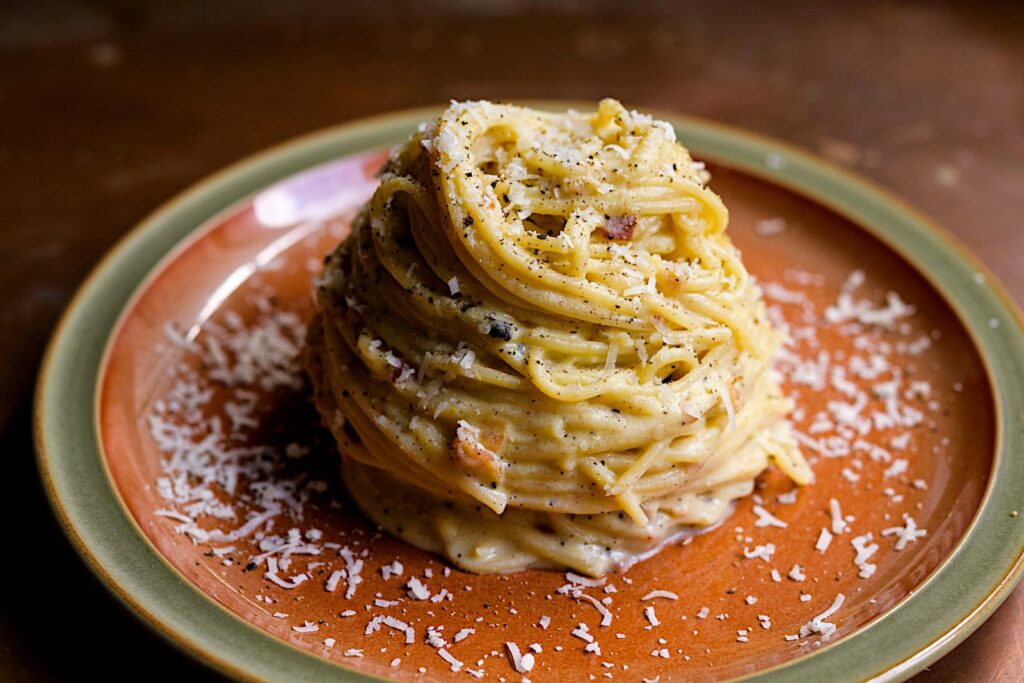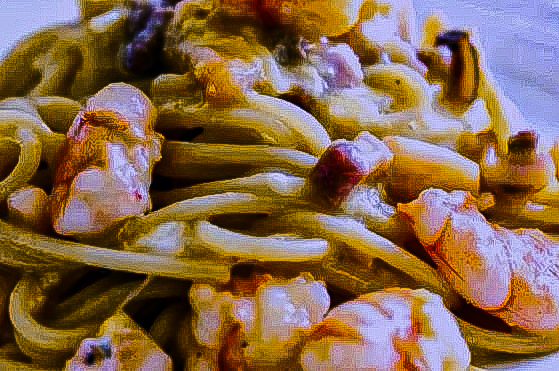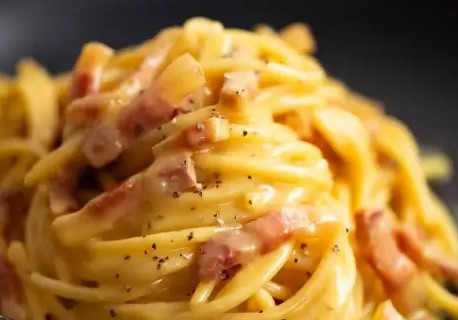
Carbonara is a popular dish throughout the world. Luca Di Leo from Barilla pasta says, “One of the great traits of pasta is its extraordinary versatility. You can combine it with pretty much anything. A carbonara base allows one to create different variations from experimenting from a roasted artichoke to sautéed shrimp. You can also make a great variation of carbonara with spices different from black pepper. Carbonara is a truly global recipe which can help bring people together.”
Carbonara di mare or seafood carbonara is an Italian beach favorite. For instance, in place of cured pork, 3 star Michelin chef Mauro Uliassi substitutes virtually anything that swims; smoked trout, small raw clams and even canned tuna.
Norbert Niederkofler, another 3 star Michelin chef famed for his “Cook the Mountain” concept, created Tyrolean Carbonara. His version features Italian Alp ingredients including leeks, Malga cheese, dehydrated speck powder and spelt flour fusilli. No beaten eggs appear in his version but he does put one whole yolk on top of the hot seasoned fusilli.
Italians might embrace variations but there are limits. A national food crisis arose when the French attempted to reinvent carbonara as a quick one-pot meal. This ordeal became “Carbonaragate” and sparked outrage and an international debate among Italian food writers, bloggers, chefs, home cooks and pasta makers. A video demonstrating the French style carbonara was viewed by more than a million Italians. They were appalled to witness bow tie pasta cooked in the same pan as diced bacon and onions, finished with crème fraiche and an unidentified cheese. Lastly this mix is topped with a raw egg and parsley.
2 star Michelin chef, Marco Sacco, says “In the kitchen, the protection and care of tradition must be able to coexist with the desire and the possibility to innovate and experiment. The original recipes must be defended and preserved, just as an artistic asset is protected in a museum or a UNESCO site. But this does not mean that maximum freedom should not be given to experiment, innovate or adapt to the territory with new ingredients. After all, it is just food. Various lands offer various cultures and preparation techniques can differ just like people do.”

Traditional Carbonara Recipe
Ingredients
12 oz of spaghetti
7 oz of guanciale
4 whole medium eggs (1 egg per serving)
1 cup + 1 tablespoon of grated Pecorino Romano
ground black pepper
Step 1 – Boil the water for the pasta while you prepare the carbonara sauce. Remember: 4 cups of water for every 3.50 oz of pasta and 1/2 tablespoon of coarse salt per 4 cups of water.
Cut the guanciale into small pieces and cook in a skillet over medium heat for about 2 to 3 minutes. Stir occasionally so that it cooks evenly. The more the guanciale cooks, the more its fat will melt and its meat will become crispy. The level of crisp is up to you. Some people like their guanciale well cooked and others prefer it soft.
No need for oil: guanciale is already fatty, oily and fabulous on its own. If you want, you can add a tablespoon of cooking water and emulsify. This will create a great oily sauce to season the spaghetti nicely. When it’s ready, turn off the heat, cover with a lid and set aside.
Step 2 – Prepare the cream. In a bowl put the eggs and pecorino Romano cheese.
Use the whole egg. Pecorino Romano, the only cheese that is recommended for making carbonara, is a very salty and flavorful Italian cheese so there is no need to add salt.
Step 3 – Add freshly ground black pepper and mix quickly until you have a creamy sauce.
Step 4 – This egg and pecorino cheese sauce should be quite thick. Set it aside for the moment.
The water should now be boiling so add the salt and cook the spaghetti. If you chose a fairly large pot, the spaghetti should fit comfortably without breaking them. Whole, unbroken spaghetti is best, so you can more easily roll them around on your fork.
Step 5 – Drain the pasta when ready. Then place them in the skillet, over high heat, to season well with the guanciale.
At this step, we have reached the crucial moment of spaghetti carbonara. Not to put tension on it, but this is the fleeting moment in which you can make an immortal dish or one that will be a real failure. So now you have to be quick, ready and dexterous. Here’s how:
Step 6 – When the spaghetti and guanciale sizzle in the pan, TURN OFF THE HEAT, otherwise the eggs will overcook and you’ll end up with scrambled eggs and pasta!
Now quickly add the eggs and pecorino cream to the hot pasta and stir. The pan is not too hot, this way the eggs will cook without lumps. Pay attention to the consistency, which should be creamy, not runny. If you notice that your carbonara is too runny, add some grated pecorino cheese. On the other hand, if you see that it’s too sticky and dense, add 1 or 2 tablespoons of pasta water.
Step 7 – Carbonara is ready. With the help of a ladle and a fork, create a pasta nest and place it on a plate.
Step 8 – Top with what’s left of the guanciale, freshly ground black pepper and grated pecorino romano to taste.
There are many quality recipes online. Check these sites out to get started.
https://www.177milkstreet.com/recipes/roman-spaghetti-carbonara
https://skinnyspatula.com/tagliatelle-carbonara/
https://www.recipetineats.com/carbonara/
https://recipe30.com/french-spaghetti-carbonara.html/

Seafood carbonara art rendition by p3
Bon Appetit, the Dude of Food
